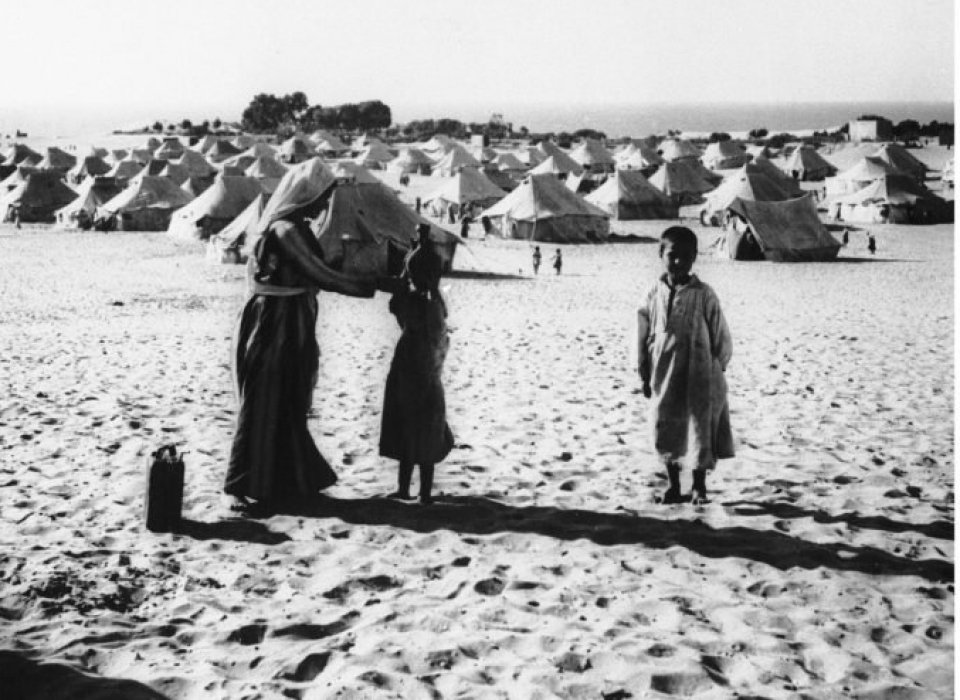Common Grounds
Israel wants to close the circle of history in Gaza
Source: Al-Jazeera
https://www.aljazeera.com/opinions/2024/10/28/israel-wants-to-close-the-circle-of-history-in-gaza
Published October 28, 2024
In 1948, Gaza became a haven for refugees. Now it may face the same fate as other depopulated Palestinian lands.

A mother and her children are seen at a tent city in the Gaza area of Egyptian-occupied Palestine on July 23, 1949 [File: AP/S Swinton]
"Equally keen to remain is also the Israelis, and this is a further reason why anyone caring about this land and its inhabitants must try to find a way to help these two people live side by side.”
Over the past year, Gaza has become synonymous with epochal catastrophe. But in ancient times, this was a place of prosperity, a strategic crossroads known as “the way of the Philistines”, which connected ancient Egypt with the land of Canaan.
Gaza is mentioned in the inscriptions of the Egyptian Pharaoh Thutmose III (1481–1425 BCE) in relation to his first military campaign in Asia. About 2,700 years later, the famous Tangier traveler Ibn Battuta (1304-1368 CE) visited Gaza and wrote that “it is a place of large dimensions … it has no wall around it”.
In the 19th century, Gaza – under Egyptian and Ottoman rule – was not only an important trade hub, but also famous for its agriculture. Historian Nabil Badran wrote that in the 1870s there were around 468 hectares (1,156 acres) of irrigated citrus groves in the Gaza area. In an 1867 memoir, James Finn, a former British consul in Jerusalem, recalled: “Another hour brought us to Asdood [Ashdod] of the Philistines, with Atna and Bait Daras on our left. I do not know where in all the Holy Land I have seen such excellent agriculture of grain, olive-trees, and orchards of fruits, as here at Ashdod.”
During the British Mandate, Gaza was one of the 16 districts of Palestine and it also encompassed Isdood (Ashdod) – which, in 1945, had a population of 4,620 Palestinians and 290 Jews – Asqalan (Ashkelon), and some parts of the western Naqab (Negev) desert.
When Gaza became a ‘strip’
The idea of a “Gaza Strip” is more recent. It is the result of the tragic history of the last 76 years, which can be summarised in one number: about 70 percent of its inhabitants come from families of refugees expelled by Zionist forces from Bait Daras, Simsim, Najd, Majdal, Huj, Abu Sitta, and dozens of other villages before and during the Arab-Palestinian-Israeli war of 1948.
The 1949 armistice agreement which formally ended that conflict demarcated the “Green Line” between the newly-created State of Israel and what came to be known as the “Gaza Strip”.
Palestinians call the expulsions and the destruction of 418 of their villages, “al-Nakba”, the catastrophe. It should be noted that the expression Nakba was not initially used by the Palestinians. While this is an Arabic word, it was used for the first time in relation to Palestine in the leaflets dropped by the Israeli army planes on the town of at-Tira near Haifa in July 1948, with the purpose of persuading Palestinians to surrender and leave their homes and villages.
It was at that historical juncture that Gaza became the main hub for Palestinian refugees.
In the words of Palestinian author Toufic Haddad, Gaza was “one of the few Palestinian cities that survived the 1948 Nakba … Gaza City became a city that was teeming with all these refugees who were displaced from their lands, and subsequently it became the seat of the first attempt to try and form an all-Palestinian national government after 1948”.
Gaza’s demographic (un)balance
In mid-October 1948, the Israeli army launched Operation Yoav a counteroffensive against the Egyptian forces in the Naqab. As a result, the refugee population in Gaza jumped from 100,000 to 230,000.
Michael Gallant, father of Israeli Defence Minister Yoav Gallant, took part in that operation. He named his son Yoav to celebrate the military campaign that, more than any other, changed Gaza’s demography.
Today, Yoav Gallant, along with other Israeli officials, is trying to close the circle of history, this time by “thinning” the Palestinian population of Gaza. A document produced by Israel’s Ministry of Intelligence leaked to the press in late October last year outlined the forcible and permanent transfer of Gaza’s 2.3 million Palestinian residents to Egypt’s Sinai Peninsula.
This idea is hardly unprecedented.
In 1953, Egypt, together with the United Nations agency for Palestinian refugees (UNRWA) and the United States, agreed on the resettlement of 12,000 Palestinian refugee families from the Gaza Strip to the Sinai Peninsula.
Following the war of 1948, Gaza had remained under Egyptian control. Cairo feared that the Palestinian resistance, which was growing by the day back then, could drag it into a confrontation with Israel, which it was keen to avoid. That is why, it was willing to go along with the plan, even at the expense of Palestinian rights, hoping it would help relieve pressure.
The resettlement, however, never took place. Massive protests broke out throughout the Gaza Strip, with Palestinians chanting slogans, such as: “No settlement. No relocation. Oh, you American agents”. The demonstrations eventually forced the Egyptian government to abandon the plan.
However, the idea of resettlement of Palestinians out of Gaza persisted. In 1956, the new Israeli foreign minister, Golda Meir, declared that “the Gaza Strip is an integral part of the land of Israel”, while Menahem Begin, the then leader of the Herut party, argued that Gaza “belonged to Israel by right”.
Israel’s then-finance minister, Levi Eshkol, allocated $500,000 to expel thousands of Palestinians to the Sinai. This plan was assigned to Ezra Danin, the same intelligence operative who in 1962 supported an operation aimed at relocating Palestinians to West Germany, where there was a shortage of labor.
After the 1967 war, in which Israel occupied Gaza, East Jerusalem, and the West Bank, the Israeli forces increased the efforts to forcibly resettle Gaza’s refugee population. They set up “emigration offices” in Gaza, offering money to those who agreed to permanently relocate. Israel’s transfer policies further intensified in the 1970s: 38,000 refugees were expelled from camps in Gaza in 1971 alone, both to the Sinai and the West Bank.
In parallel, Israel started illegal Jewish settlements in the Strip. Between 1967 and 2005, a “proto-colonial” situation prevailed in the Gaza Strip. A few thousand Israeli settlers controlled about 40 percent of the arable land and a large part of the water resources.
In 2004, Giora Eiland, who served as the head of the Israeli National Security Council between 2004 and 2006, proposed that Egypt accommodate the Palestinian population of the Gaza Strip in northern Sinai in exchange for some Israeli territory that would allow a land link to be built to Jordan.
Eiland’s proposal was not implemented, and in 2005, a few months before a stroke put him in a permanent coma, Israeli Prime Minister Ariel Sharon removed 7,000 Jewish settlers from occupied Gaza, and simultaneously settled tens of thousands of others across the occupied West Bank.
As Eyal Weizman, director of Forensic Architecture, explained in a 2014 article, Israel’s unilateral disengagement from Gaza was “part of the same national security logic of unilateral solutions that the settlements [are] part of – perpetuating and intensifying animosity and violence, rather than undoing them”.
History ahead
Despite the epochal catastrophe currently unfolding in Gaza (and, mutatis mutandis, in the West Bank) and the attempts by the Israeli authorities to close the circle of history, resistance to expulsions and relocations by average Palestinians is fiercer than ever. They know what “temporary” means and are aware that there is no “right of return” for them.
Equally keen to remain are also the Israelis, and this is a further reason why anyone caring about this land and its inhabitants must try to find a way to help these two people live side by side.
How to do so? Acknowledging the huge price that Palestinians paid so that the objectives of their counterpart could be fulfilled does not negate the rights of anyone and is a step in the right direction: a direction which strives to bend the arc of history away from structural oppression, and takes into account the scars and the rights of Palestinians and Israelis alike.
Lorenzo Kamel
Professor of History of International Relations at the University of Turin.
Professor Lorenzo Kamel teaches History of International Relations at the University of Turin. His latest book, History Below the Global. On and Beyond the Coloniality of Power in Historical Research, will be out in April 2024.
LATEST OPEN LETTERS
-
21-07Freedom
-
20-03Stand up to Trump
-
18-02Average Americans Response
-
23-12Tens of thousands of dead children.......this must stop
-
05-06A Call to Action: Uniting for a Lasting Peace in the Holy Land
-
28-05Concerned world citizen
-
13-02World Peace
-
05-12My scream to the world
-
16-11To Syria and Bashar al-Assad
-
16-11To Palestine
VIRTUAL POST OFFICE
PETITIONS
LINKS
DONATION
Latest Blog Articles
-
30-12The World Radicalized by the Gaza Genocide
-
30-12Opinion | Trump's Gaza Cease-fire Is Theater Disguising Israel's Desire to Prolong the War
-
30-12How the Jewish Chronicle weaponises 'antisemitism' to fuel a moral panic
-
29-12The Evangelical Pope | Europe … Free at Last
-
25-12Our Friday News Analysis | What the World Reads Now!
-
24-12Our Wednesday News Analysis | Why Palestinians face the same fate, weapons or not
-
23-12Why Palestinians face the same fate, weapons or not
-
23-12Western elites fear a ‘globalised intifada’ because they are its targets, not Jews
-
23-12A smaller cage: Israel’s ‘two-state solution’ on Gaza’s ruins
-
22-12The Evangelical Pope | A Humane Future Before God
-
17-12Our Wednesday News Analysis | Gaza and the unravelling of a world order built on power
Latest Comments
 One of the most important and illuminating articles that I …
One of the most important and illuminating articles that I …
Comment by Benjamin Inbaraj And what's wrong here?
After all, there is the homeland …
And what's wrong here?
After all, there is the homeland …
Comment by Isac Boian Does this reinforce or deny my argument that Israel is …
Does this reinforce or deny my argument that Israel is …
Comment by Edward Campbell Many 'say' they support the Palestinian cause but do little …
Many 'say' they support the Palestinian cause but do little …
Comment by Philip McFedries The UN is strangled by the "war for profit" cabal …
The UN is strangled by the "war for profit" cabal …
Comment by Philip McFedries I can't read the printing on the map.
I can't read the printing on the map.
Comment by Philip McFedries Good news!
Good news!
Comment by Philip McFedries

COMMENTS
This article has 0 comments at this time. We invoke you to participate the discussion and leave your comment below. Share your opinion and let the world know.